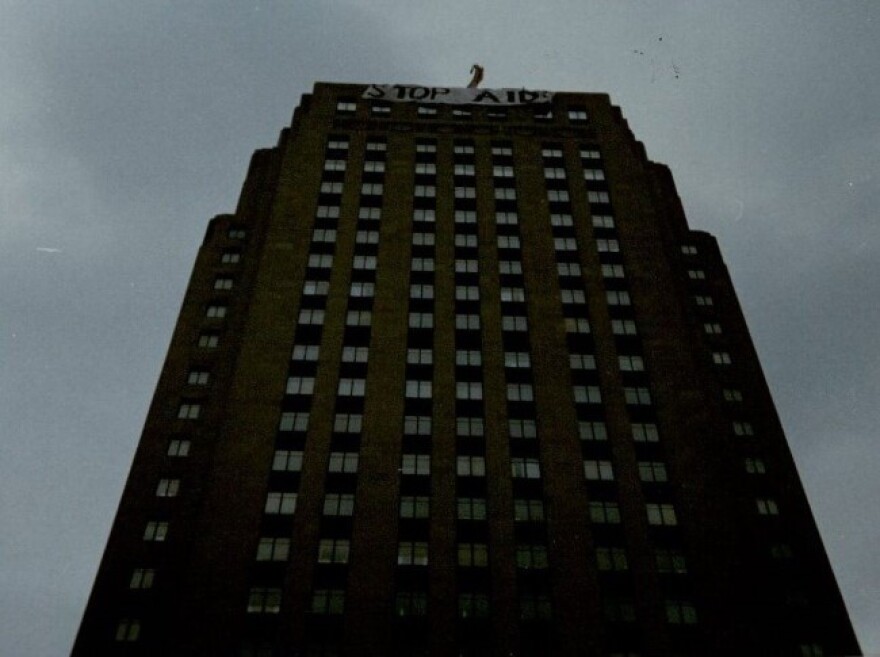After the U.S. Supreme Court's recent marriage equality ruling, members of Kansas City’s gay, lesbian, bisexual and transgender communities will begin turning their attention to other issues. Meanwhile, three pioneers of the gay-rights movement provided KCUR with some historical context for LGBT activism in Kansas City.
Three decades of local activism began in the late 1980s, when gay men and women all across the country were responding to the AIDS crisis. One of the organizations was ACT-UP, the AIDS Coalition to Unleash Power. Jon Barnett founded the local chapter.
“A group of mostly gay men would meet and decide to do civil disobedience to draw attention: We need funding, we need a cure, care, we — meaning the gay community — can’t do this by ourselves and you’re not paying attention," Barnett explains. "The one (action) that took a lot of effort, planning and execution was hanging a 20-foot banner off the observation deck of City Hall that said ‘Stop AIDS’ during a city council meeting.”

Some women in town were running Phoenix Books, a feminist-LGBT bookstore near 39th and Main; it later moved to Westport. In those days, before social media, it was a place for people to find each other and where they could feel normal.
“I have very strong memories of transgender folks who would come in, check out the place to see if it was a place they could be safe. The next week they would come in as their true selves maybe the first time ever out in public" says Anne Shelley, the bookstore's manager (Shelley now lives in Arkansas).
Phoenix Books was also a place for political organizing.

“We were really learning how to exercise our muscles of democracy, how develop a voice and make public policy that empowered our lives,” Shelley remembers.
Those efforts coalesced when Barnett ran for city council in 1991.

“As I recall," Barnett says, "the Greens were looking for candidates to put forth in city elections. I was approached to run as an openly gay candidate. It wasn’t a very hard sell, because one of the things we’d struggled with was convincing council members that we existed, that we were a voting bloc, that we were a community. We had no proof.”
Barnett didn’t win his election for city council, but his run helped provide that proof. And in 1993, when Emanuel Cleaver was mayor, the city council passed an ordinance prohibiting discrimination based on sexual orientation. Barnett’s campaign also set up another victory: It created the voting maps that helped elect Missouri's first openly gay state representative.
Tim Van Zandt says he received a phone call from Karen McCarthy, a longtime member of the Missouri House, who was making a run for the United States Congress. That opened up her seat in Midtown.
"She called me and said 'you guys' should be thinking about a candidate you can support," Van Zandt says. "It was a pretty heavy decision to make."

There were plenty of reasons to be cautious, and Kansas City had a unique one.
“Fred Phelps launched his whole campaign of hatred on the streets of Kansas City,” Shelley notes.
“You’re in the paper, you’re going door to door, you’re passing out materials. Your name, your face, your picture, everything is all over," Van Zandt says. "And I just thought, I’m going to wake up any day and Fred Phelps is going to be in front of my house.”
Van Zandt won, entering the Missouri House of Representatives in 1994.
“I was elected for the first openly gay member of legislature the same year as first openly gay member of the California legislature, Sheila Kuehl, was elected. So maybe weren’t as backwards or slow to the table as people thought."
When he got to Jefferson City, Van Zandt says, he was well-received by his fellow legislators.
“I never had a bad experience," Van Zandt says. "This was more funny than anything: Two or three years after I’d been there, sitting on house floor one day, sometimes during dull debates you get into a conversation, and this was a House member from a rural part of the state who said, 'You know, they said a few years back there was some queer that would be elected to the House.' I didn’t say, 'That queer’s me!' You wonder: Were they expecting three heads? Wearing a dress?”
Van Zandt served in the legislature until 2002, when term limits forced him out. During that time, he says, "everything" changed for Kansas City's LGBT community.
“Truly, everything," he says. "I mean, socially, politically, culturally — everything.”

“In the politics of Kansas City today, every council member in every district pays attention to the gay community," says former city council candidate Jon Barnett.

"I get a little choked up and emotional because the change has been so great. I see the mayor of Kansas City tweeting to the national gay community, 'Hey, come to Kansas City — we want you here. We want your energy and creativity. We want you here.' And I see these young activists who are going places and doing things, and think, it was all worth it."
Wonderful things have happened, and the community has more services, Barnett notes.
"And yet, and yet, and yet: So much more needs to be done," he says. "The goalpost just moved to a place I would have never have dreamed of or imagined three decades ago.”
As Kansas City's LGBT community sets new goals, meeting them will be up to a new generation of activists.


